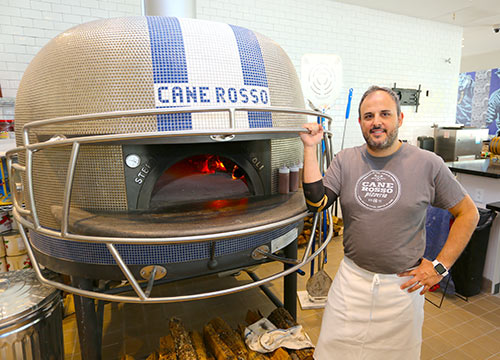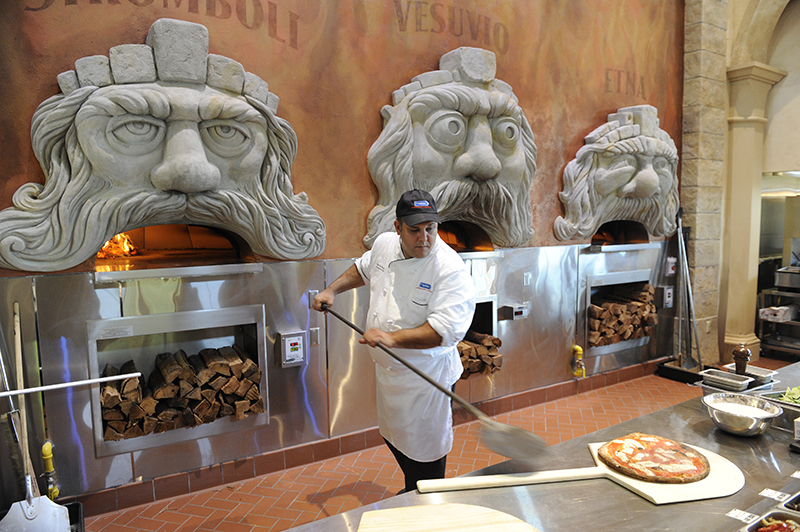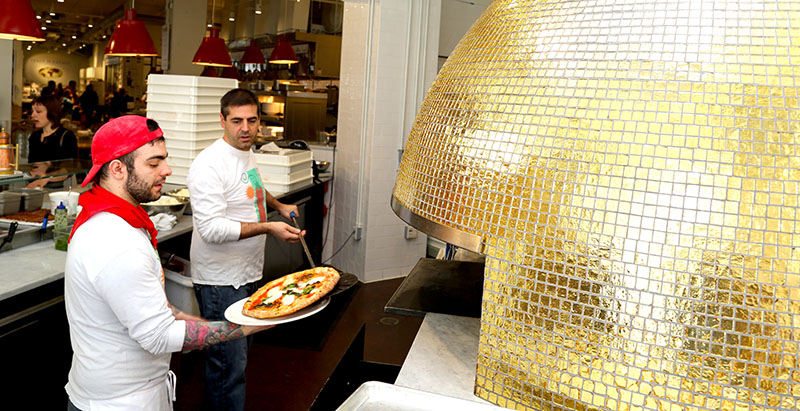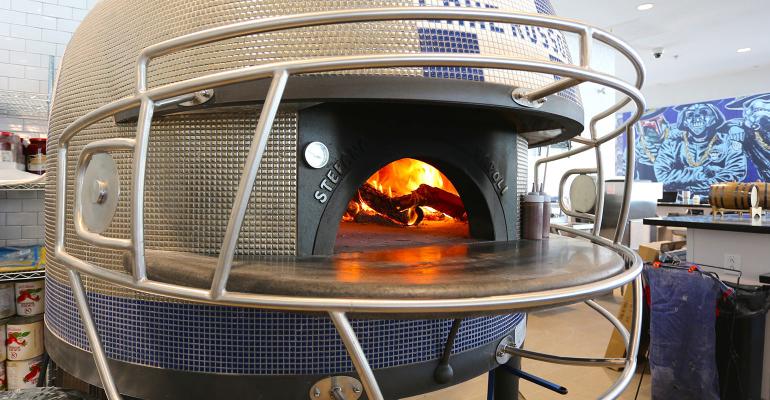Because of their size and the theater of the pizza-making process, wood-burning ovens can easily be the focal point of a restaurant. Some operators, however, are turning their pizza ovens into core design elements.
Cane Rosso, for example, a restaurant at The Star, the new multi-use Frisco, Texas, headquarters complex of the Dallas Cowboys NFL team, has turned its pizza oven into an Instagramable backdrop.
The ninth restaurant for the growing Cane Rosso brand, through clever design work, opened in late July with an Italian-made oven that mimics a giant silver-and-blue helmet of the Cowboys uniform.
Dino Santonicola, executive chef for Dallas-based Cane Rosso, said the company worked with the Italian-based manufacturer of eight of its Neopolitan-styled ovens, the first of which debuted in 2011, when owner Jay Jerrier moved his mobile catering business into a brick-and-mortar location.
 When Cane Rosso opened its ninth location in the Dallas Cowboys’ Star project in Frisco, Texas, chef Dino Santonicola said the shape of the Italian-made wood-burning oven lent itself to a themed football shape. (Photo by Ron Ruggless)
When Cane Rosso opened its ninth location in the Dallas Cowboys’ Star project in Frisco, Texas, chef Dino Santonicola said the shape of the Italian-made wood-burning oven lent itself to a themed football shape. (Photo by Ron Ruggless)
The oven’s rounded shape was ideal for the helmet theme, especially with the addition of metal to resemble a facemask.
“We were in a meeting and the discussion about the oven came up,” Santonicola recalled. “Jay said it needed to be special, and I said we should do the Cowboys helmet. It was not easy to execute, because it required a lot of measurements, pictures, Photoshop and an in-person meeting.”
The gussied-up ovens are more expensive, said Santonicola, who oversees the nine Texas Cane Rosso locations: six in Dallas-Fort Worth, two in Houston and one in Austin. The ovens at the Austin location are manufactured by a Washington, D.C. firm.
“Custom ordering was more expensive,” Santonicola said. “We all know that anything you have custom-made costs more, but for us it was very important. What helped me was that I can speak fluently in both languages, so I was able to describe exactly what we wanted.”
Santonicola said the Cane Rosso ovens reach 900 degrees, so they are positioned well within eyeshot but not so close to the customers as to leave them hot-headed.
Cane Rosso’s ovens can cook pizzas in 90 seconds to produce the light, slightly charred crust that distinguishes Neapolitan pies.
The best advice to any operator considering making the wood-burning ovens into a design centerpiece “is to be patient,” Santonicola said.
“You have to deal with a lot factors during this process — ordering, building, shipping, customizing, brokers and the delivery company,” he explained.
 Photo by Patina Restaurant Group
Photo by Patina Restaurant Group
In Lake Buena Vista, Fla., Patina Restaurant Group in 2010 installed dramatic wood-burning ovens (above) at its Via Napoli restaurant, which is adjacent to Tutto Italia Ristorante in the Italy pavilion at Epcot World Showcase in the Walt Disney World Resort.
Via Napoli’s three fire-belching ovens are named after the three active volcanoes in Italy — Mount Etna, Mount Vesuvius and Stromboli — and sculpted to reflect the faces of the molten-mountain gods.
“The ovens are beautiful and eye-catching, but remember that they are working ovens and very hot — 800 degrees and more,” said Tanja Yokum, the Patina Restaurant Group’s director of public relations and marketing.
“They need to be cleaned and maintained and require a fair amount of work to keep in perfect working order,” she said.
And, while guests must keep their distance, “It’s exciting for guests to see the working ovens in action during service,” she said. “They create a sense of anticipation and people love to watch their food being cooked right in front of them.”
Tthe ovens also serve the more important purpose of speed and deliciousness.
“The ovens create a wonderful pizza, authentic to the way they are made in Italy,” Yokum said. “The high heat cooks the pizza very quickly — and it’s an efficient way to work in a busy restaurant.”
But the result can add a high level of entertainment to set their restaurants apart from traditional pizza concepts, Yokum said.
“The cooks tending the ovens create live entertainment in the restaurant,” she said. “Also, with a central focal point, there is no such thing as a ‘bad table’ in the house.”
The growing Eataly chain, with locations in Chicago, New York and Boston, also use custom-built pizza ovens that literally shine in the spotlight.
The ovens are covered with a Bisazza mosaic with gold foil, designed by Riccardo Dalisi for Rossopomodoro, the pizza company within Eataly locations.
 Photo by Ron Ruggless
Photo by Ron Ruggless
The ovens are made in Naples by Stefano Ferrara, but shipped in pieces to each Eataly location and built inside the stores.
“Rossopomodoro considers the ovens the temple of pizza,” said a spokesperson. “A structure to adore and admire.”





